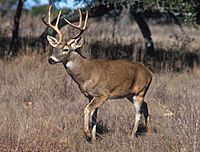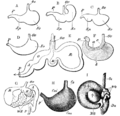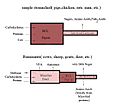Ruminants facts for kids
Quick facts for kids RuminantiaTemporal range: Late Eocene? to Recent
|
|
|---|---|
 |
|
| White-tailed Deer | |
| Scientific classification | |
| Kingdom: | |
| Phylum: | |
| Class: | |
| Order: | |
| Suborder: |
Ruminantia
Scopoli, 1777
|
| Families | |
|
Tragulidae |
|
Ruminantia is a group of hoofed mammals that includes many well-known animals like sheep, goats, deer, and cattle. These animals are special because they have a unique digestive system. They have a complex, multi-chambered stomach that helps them break down tough plant material.
One of the most interesting things about ruminants is that they "chew their cud." This means they swallow their food, then bring it back up to chew it again. This process helps them get all the nutrients from their food.
Contents
What Makes Ruminants Special?
Ruminants are a big group of animals. They are part of a larger order called Cetartiodactyla. This order also includes animals like pigs, camels, whales, and hippos. However, ruminants stand out because of their special stomach.
How Do Ruminants Digest Food?
Ruminants have a stomach with four different chambers. These are the rumen, reticulum, omasum, and abomasum. Each part has a special job in digesting food.
- Rumen: This is the largest chamber. It acts like a big fermentation vat. Billions of tiny microbes (bacteria and other microorganisms) live here. They help break down tough plant fibers like cellulose.
- Reticulum: This chamber works with the rumen. It helps sort food particles. It also traps any heavy or unwanted objects the animal might have swallowed.
- Omasum: This chamber absorbs water and nutrients from the partly digested food. It also grinds the food further.
- Abomasum: This is the "true stomach." It is similar to a human stomach. It produces strong acids and enzymes to finish the digestion process.
After food goes through these chambers, it moves to the small and large intestines. Here, more nutrients are absorbed.
Why Do Ruminants Chew Their Cud?
Chewing cud, also called rumination, is very important for these animals. When a ruminant eats, it quickly swallows large amounts of grass or other plants. This food goes into the rumen and reticulum.
Later, when the animal is resting, it brings small bits of this food back into its mouth. It then chews this "cud" slowly and thoroughly. This extra chewing breaks down the plant material even more. This makes it easier for the microbes in the stomach to work. It also helps the animal absorb more nutrients.
Types of Ruminants
The Ruminantia suborder includes several families of animals. Each family has its own unique features.
- Mouse Deer (Tragulidae): These are small, shy animals. They are often called chevrotains. They are some of the smallest hoofed mammals.
- Musk Deer (Moschidae): These deer-like animals are known for producing musk. Musk is a strong-smelling substance used in perfumes.
- Deer (Cervidae): This family includes many types of deer. Examples are moose, reindeer, and white-tailed deer. Most male deer grow antlers, which they shed each year.
- Giraffes and Okapis (Giraffidae): These are the tallest land animals. Giraffes are known for their very long necks. Okapis look a bit like zebras but are related to giraffes.
- Pronghorns (Antilocapridae): The pronghorn is found in North America. It is the fastest land animal in the Western Hemisphere. It has unique horns that it sheds every year.
- Cattle, Goats, Sheep, and Antelopes (Bovidae): This is a very large and diverse family. It includes many animals important to humans, like cattle, goats, and sheep. It also includes many kinds of antelopes.
Related Pages
Images for kids
-
Different forms of the stomach in mammals. A, dog; B, Mus decumanus; C, Mus musculus; D, weasel; E, scheme of the ruminant stomach, the arrow with the dotted line showing the course taken by the food; F, human stomach. a, minor curvature; b, major curvature; c, cardiac end G, camel; H, Echidna aculeata. Cma, major curvature; Cmi, minor curvature. I, Bradypus tridactylus Du, duodenum; MB, coecal diverticulum; **, outgrowths of duodenum; †, reticulum; ††, rumen. A (in E and G), abomasum; Ca, cardiac division; O, psalterium; Oe, oesophagus; P, pylorus; R (to the right in E and to the left in G), rumen; R (to the left in E and to the right in G), reticulum; Sc, cardiac division; Sp, pyloric division; WZ, water-cells. (from Wiedersheim's Comparative Anatomy)
See also
 In Spanish: Ruminantia para niños
In Spanish: Ruminantia para niños




